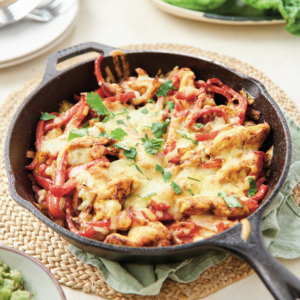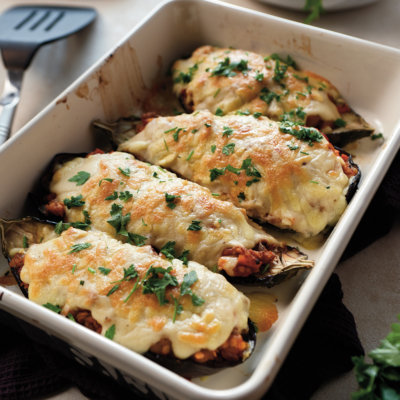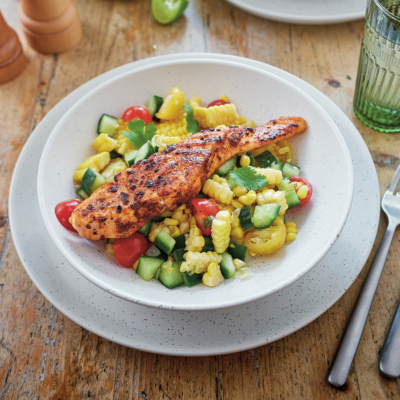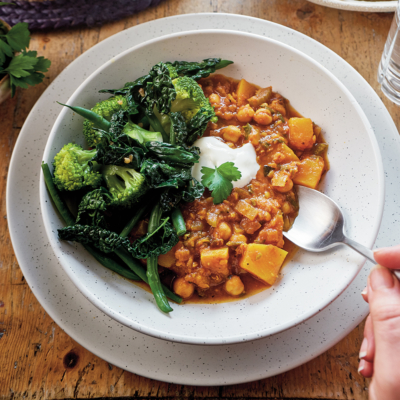The best way to ensure we’re eating healthy, balanced meals is to plan ahead. Making a weekly meal plan and shopping for the relevant ingredients helps us to be in control of what we’re eating.
However, sometimes life gets in the way. It might be that supermarkets don’t have what we need in stock, we might not feel well enough to go to the shops, or we might want to use up other ingredients we already have at home.
In that case, it’s important to remember that many ingredients in different meals and recipes can easily be swapped for alternatives. The simplest way to make swaps is to choose foods from the same food group, e.g. protein for protein or vegetables for vegetables. Keep in mind you can also swap fresh for frozen ingredients if those are more readily available – frozen is just as nutritious as fresh!
The dietitians here at Second Nature have provided our top tips for food swaps, picked out our six most popular recipes as examples of easy ingredient swaps, and added some general food-swapping advice. There are a number of possible food swaps for all foods, but these are just a couple of examples.
On the Second Nature programme, your digital health coach can help you make food swaps with any ingredients you have at home if you’re unsure.
Medication-assisted weight loss with a future focus
Start with Mounjaro, transition to habit-based health with our support

Top tips for making food swaps
1) Swap like-for-like
Where possible, make swaps within the same food groups. This will mean we keep our meals balanced, for example, by swapping protein for protein, veg for veg, or healthy fat for healthy fat.
2) Use up fresh ingredients you already have
To minimise food waste and unnecessary spending, try to make swaps based around the foods you already have in your fridge.
3) Swap to suit your needs
Remember that swaps can be made for all recipes and meals to become vegan or vegetarian, or to include meat. The same applies for any ingredients we don’t like!
4) Keep your freezer stocked
Try to regularly top up your freezer with mixed veg, protein (chicken, fish, meat, or tofu), healthy fats (chopped avocados, salmon), and carb options (rye bread, sweet potato chunks) as you use them. This will provide more options for swaps.
5) Pay attention to your pantry
Aim to have a variety of herbs and spices (e.g. oregano, cumin, turmeric) and pantry staples (e.g. rice, stock, tinned legumes, and lentils) at home. At the very least, chopped tomatoes, tomato paste, and dried mixed herbs are extremely versatile!
Recipes: how to food swap
1) Chicken fajita bake
| Ingredient | Swap |
| Chicken | Fish fillet Prawns Steak Lamb fillet Tofu Tinned black beans/kidney beans Tinned chickpeas/lentils |
| Peppers | Frozen peppers Frozen/fresh green beans Sliced courgette Sliced aubergine Diced cauliflower Sliced cabbage |
| Chilli powder | Chopped fresh chilli (red or green) Dried Chilli flakes Cayenne pepper Cajun seasoning Chilli paste |
| Cheddar cheese | Any hard cheese Feta Goats cheese |
| Sour cream | Natural, full-fat yoghurt + lemon juice Creme fraiche Cottage cheese |
| Fresh coriander garnish | Fresh parsley Chives |
2) Cheesy aubergines
| Ingredient | Swap |
| Aubergine | Peppers Portobello mushrooms Butternut squash Courgette |
| Red onion | White onion Frozen, chopped onion Spring onion 1 tsp dried onion |
| Dried red lentils | 2 x tin lentils Yellow lentils Puy lentils 2 x tin chickpeas |
| Chopped tomatoes | Tomato passata Tinned plum tomatoes Cherry tomatoes |
| Carrot | Courgette Frozen peas/carrots/sweetcorn Tinned peas/carrots/sweetcorn Fresh/frozen peppers Fresh/frozen kale Fresh/frozen green beans |
| Cheddar cheese | Any hard cheese Feta Goats cheese Halloumi |
| Fresh parsley garnish | Fresh basil Fresh coriander Fresh thyme Fresh sage Fresh mint |
3) Cajun salmon
| Ingredient | Swap |
| Salmon fillets | Any fish fillets Frozen fish fillets Chicken breasts/thighs Frozen/fresh prawns Tofu 1 x tin black beans/kidney beans 1 x tin chickpeas/lentils |
| Sweetcorn | Tinned sweetcorn Frozen peas/carrots/sweetcorn Tinned peas/carrot/sweetcorn Chopped carrots Mangetout Peppers |
| Cherry tomatoes | Cucumber Frozen/fresh peppers Radish Carrots Red onion |
| Avocado | Olives Nuts |
| Fresh coriander garnish | Fresh basil Fresh parsley |
4) Morrocan butternut stew
| Ingredient | Swap |
| Pumpkin | Butternut squash Marrow Aubergine Courgette Mushrooms |
| Dried red lentils | Diced chicken pieces Frozen/fresh prawns Tinned lentils Yellow lentils Puy lentils Tinned chickpeas |
| Tinned chickpeas | Tinned black beans Tinned Kidney beans Tinned butter beans |
| Tomato passata | Chopped tomatoes Tinned plum tomatoes Cherry tomatoes |
| Fresh coriander | Dried coriander |
| Fresh parsley | Dried parsley |
| Vegetable stock | Chicken stock Beef stock |
| Bay leaves | Dried thyme Dried oregano |
5) Lentil bolognese
| Ingredient | Swap |
| Green pepper | Red pepper Yellow pepper Frozen pepper Fresh carrots Frozen peas/carrots/sweetcorn Tinned peas/carrots/sweetcorn Celery Diced broccoli |
| Courgette | Aubergine Butternut squash Asparagus Frozen peas/carrots/sweetcorn Tinned peas/carrots/sweetcorn |
| Mushrooms | Fresh/frozen carrots |
| Tinned lentils | Dried puy lentils Dried red lentils Minced Beef Tinned black beans Tinned kidney beans |
| Chopped tomatoes | Passata Tinned plum tomatoes Cherry tomatoes |
| Fresh basil | Fresh parsley Dried basil |
| Vegetarian hard cheese | Vegan cheese Any hard cheese Feta Grated halloumi |
| Wholewheat pasta | Brown rice Sweet potato Quinoa Wholemeal wrap White pasta White rice Orzo Couscous |
6) Medittereanean quinoa
| Ingredient | Swap |
| Vegetable stock | Chicken stock Beef stock |
| Quinoa | Cooked quinoa packet Wholewheat pasta Brown rice Frozen/fresh sweet potato Wholemeal wrap |
| Red onion | White onion frozen, chopped onion |
| Aubergine | Courgette Butternut squash Mushrooms Frozen peas/carrots/sweetcorn Tinned peas/carrots/sweetcorn Sweet potato |
| Courgette | Mushrooms Tomatoes Frozen/fresh carrots |
| Pepper | Frozen pepper Frozen peas/carrots/sweetcorn Tinned peas/carrots/sweetcorn |
| Chopped tomatoes | Passata Tinned plum tomatoes Cherry tomatoes 2 tbsp butter + 2 tbsp tomato paste |
| Fresh basil garnish | Fresh parsley |
General food swaps
To help inspire some ideas, below are categories with food items that can be used interchangeably in a number of different recipes and meals, depending on what dish we’re making and our preferences.
Now we’re spending more time than usual at home, it could be a good opportunity to experiment with different ingredients and flavours to see what we like!
Proteins
Protein is needed to help our body grow, maintain, and repair itself; it’s what helps us to build muscle and stay strong. When you eat protein, your body digests it into smaller components called amino acids.
Eating a variety of protein is important as it ensures that our body is getting a wide range of essential and non-essential amino acids. Eating protein with your meals also has the benefit of helping you to feel full, as it takes longer to digest.
- White meat (chicken, duck, turkey)
- Red meat (beef, lamb, veal, venison)
- Pork
- Tuna
- White fish (basa, cod, haddock, halibut, plaice)
- Oily fish (anchovy, mackerel, salmon, sardines, trout) Shellfish (crab, lobster, prawns)
- Molluscs (clams, mussels, oysters)
- Eggs
- Tofu
- Tempeh
- Lentils
- Beans (soy, black, kidney, cannellini, borlotti beans)
- Chickpeas (including hummus)
- Milk (whole, semi-skimmed, or skimmed)
- Natural yoghurt
- Cheese
- Unsweetened dairy alternatives
Vegetables
Vegetables contain a large number of vitamins and minerals, as well as fibre, which keeps us feeling fuller for longer. The list below includes non-starchy vegetables, as starchy vegetables are relatively high in carbohydrate (these are included in the ‘Carbohydrates’ section below).
- Salad (pepper, cucumber, tomato, celery, lettuce, salad leaves, radish)
- Root vegetables (beetroot, carrot, celeriac, daikon, parsnip, swede, turnip)
- Courgette, aubergine, marrow, pumpkin, squash, butternut squash
- Leafy greens (spinach, pak choi, swiss chard, kale)
- Broccoli, cauliflower, asparagus, cabbage, brussels sprouts
- Corn, green / broad / runner beans, peas, mangetout
- Onion, leek, garlic, fennel
- Mushrooms
- Bamboo shoots and bean sprouts
Healthy fats
Fat is used in our body for a wide range of processes, such as building the walls of our cells, allowing our brain and nervous system to function, and producing a wide range of hormones.
Similarly to protein, there are a number of ‘essential’ dietary fats needed for survival that can’t be produced by our body. These are called the omega-3 and omega-6 essential fatty acids. Dietary fats provide more energy compared to other macronutrients, but are also digested slowly. For this reason, adding healthy fats to your meals helps us feel fuller for longer.
- Butter or coconut oil (all-heat cooking)
- Extra virgin olive oil (cold use and medium-heat cooking)
- Cold-pressed sesame oil and peanut oil (cold use and lower-heat cooking)
- Peanuts (or unsweetened peanut butter)
- Almonds (or unsweetened almond butter)
- Hazelnuts
- Pinenuts
- Pistachios
- Walnuts
- Macadamia
- Brazil nuts
- Cashews
- Milled flaxseed or linseed
- Chia seeds
- Sesame seeds
- Pumpkin seeds
- Sunflower seeds
- Avocado
- Olives
Carbohydrates
Carbohydrates are a source of energy for our body: these include sugars, starch, and fibre. When we digest carbohydrates, they’re broken down into individual units of sugar, mainly glucose. Glucose is what the body’s cells use as energy.
For those of us who’re very active during the day, eating plenty of carbs might be fine, but many of us live quite sedentary lives. If weight loss is our goal, science says that following a lower-carbohydrate diet might be effective.
Some carbohydrate foods are higher in fibre. These foods are called complex carbohydrates. Fibre can help food to move through your digestive system and remove any waste products with it. Eating fibre-containing foods also helps you feel fuller for longer and maintains the good bacteria in your gut, which has been linked with many digestive health benefits. The list below includes starchy vegetables, fruit, and complex carbohydrates.
- Wholegrain bread
- Rye bread
- Wholewheat pasta
- Brown rice
- Quinoa
- Barley
- Oats
- Buckwheat
- Freekeh
- Sweet potatoes
- Plantain
- Yam
- Cassava
- Berries
- Banana
- Plums
- Tropical fruit (watermelon, pineapple, mango)
- Grapes
Herbs and spices
Herbs and spices can often be swapped for other similar ones and depend on our taste preferences.
If you’re unsure of what to use, an easy swap for any fresh herbs or dry ones you don’t have can be dried mixed herbs (for tomato-based dishes) or curry powder (for curry style dishes). For anything where you’d like a bit of heat (e.g. chicken or roast vegetables), cayenne pepper, chilli powder, and paprika are great alone or combined.
We’ve combined herbs and spices on each row that compliment each other, but that also can be swapped for one another (depending on our preferences):
- Basil, chives, parsley
- Dill, marjoram, oregano, tarragon
- Bay leaves, rosemary, sage, thyme
- Coriander, mint, lemongrass, Thai basil
- Cardamom, coriander seeds, cumin, turmeric
- Caraway, paprika, saffron
- Cinnamon, cloves, ground ginger, nutmeg








